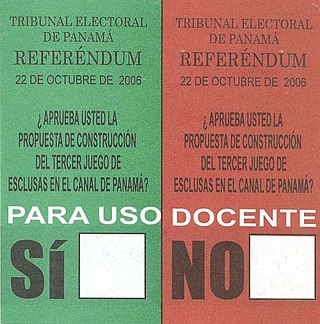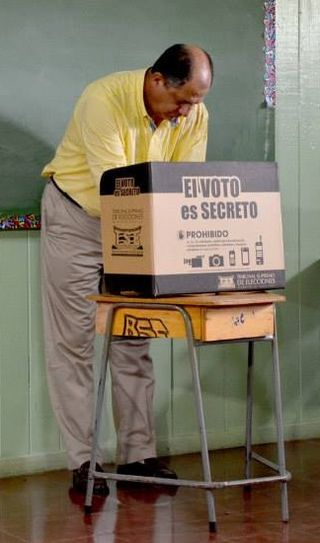
Voting is a method by which a group, such as a meeting or an electorate, can engage for the purpose of making a collective decision or expressing an opinion usually following discussions, debates or election campaigns. Democracies elect holders of high office by voting. Residents of a jurisdiction represented by an elected official are called "constituents," and the constituents who choose to cast a ballot for their chosen candidate are called "voters." There are different systems for collecting votes, but while many of the systems used in decision-making can also be used as electoral systems, any which cater for proportional representation can only be used in elections.
A voting machine is a machine used to record votes in an election without paper. The first voting machines were mechanical but it is increasingly more common to use electronic voting machines. Traditionally, a voting machine has been defined by its mechanism, and whether the system tallies votes at each voting location, or centrally. Voting machines should not be confused with tabulating machines, which count votes done by paper ballot.
The Australian electoral system comprises the laws and processes used for the election of members of the Australian Parliament and is governed primarily by the Commonwealth Electoral Act 1918. The system presently has a number of distinctive features including compulsory enrolment; compulsory voting; majority-preferential instant-runoff voting in single-member seats to elect the lower house, the House of Representatives; and the use of the single transferable vote proportional representation system to elect the upper house, the Senate.
Electronic voting is voting that uses electronic means to either aid or take care of casting and counting ballots.
Norway elects its legislature on a national level. The parliament, the Storting, has 169 members elected for a four-year term by a form of proportional representation in multi-seat constituencies.

The secret ballot, also known as the Australian ballot, is a voting method in which a voter's identity in an election or a referendum is anonymous. This forestalls attempts to influence the voter by intimidation, blackmailing, and potential vote buying. This system is one means of achieving the goal of political privacy.

Electronic voting is the standard means of conducting elections using Electronic Voting Machines (EVMs) in India. The system was developed and tested by the state-owned Electronics Corporation of India and Bharat Electronics in the 1990s. They were introduced in Indian elections between 1998 and 2001, in a phased manner. Prior to the introduction of electronic voting, India used paper ballots and manual counting. The paper ballots method was widely criticised because of fraudulent voting and booth capturing, where party loyalists captured booths and stuffed them with pre-filled fake ballots. The printed paper ballots were also more expensive, requiring substantial post-voting resources to count hundreds of millions of individual ballots. Embedded EVM features such as "electronically limiting the rate of casting votes to five per minute", a security "lock-close" feature, an electronic database of "voting signatures and thumb impressions" to confirm the identity of the voter, conducting elections in phases over several weeks while deploying extensive security personnel at each booth have helped reduce electoral fraud and abuse, eliminate booth capturing and create more competitive and fairer elections. Indian EVMs are stand-alone machines built with once write, read-only memory. The EVMs are produced with secure manufacturing practices, and by design, are self-contained, battery-powered and lack any networking capability. They do not have any wireless or wired internet components and interface. The M3 version of the EVMs includes the VVPAT system.
An election exit poll is a poll of voters taken immediately after they have exited the polling stations. A similar poll conducted before actual voters have voted is called an entrance poll. Pollsters – usually private companies working for newspapers or broadcasters – conduct exit polls to gain an early indication as to how an election has turned out, as in many elections the actual result may take hours to count.
An absentee ballot is a vote cast by someone who is unable or unwilling to attend the official polling station to which the voter is normally allocated. Methods include voting at a different location, postal voting, proxy voting and online voting. Increasing the ease of access to absentee ballots is seen by many as one way to improve voter turnout through convenience voting, though some countries require that a valid reason, such as infirmity or travel, be given before a voter can participate in an absentee ballot. Early voting overlaps with absentee voting. Early voting includes votes cast before the official election day(s), by mail, online or in-person at voting centers which are open for the purpose. Some places call early in-person voting a form of "absentee" voting, since voters are absent from the polling place on election day.
Early voting, also called advance polling or pre-poll voting, is a convenience voting process by which voters in a public election can vote before a scheduled election day. Early voting can take place remotely, such as via postal voting, or in person, usually in designated early voting polling stations. The availability and time periods for early voting vary among jurisdictions and types of election. The goals of early voting are usually to increase voter participation, relieve congestion at polling stations on election day, and avoid possible discrimination against people with work and travel schedules that may effectively prohibit them from getting to the polls during the hours provided in a single election day.

Postal voting is voting in an election where ballot papers are distributed to electors by post, in contrast to electors voting in person at a polling station or electronically via an electronic voting system.
India has a parliamentary system as defined by its constitution, with power distributed between the central government and the states.
Elections in Israel are based on nationwide proportional representation. The electoral threshold is currently set at 3.25%, with the number of seats a party receives in the Knesset being proportional to the number of votes it receives. The Knesset is elected for a four-year term, although most governments have not served a full term and early elections are a frequent occurrence. Israel has a multi-party system based on coalition governments as no party has ever won a majority of seats in a national election, although the Alignment briefly held a majority following its formation by an alliance of several different parties prior to the 1969 elections. Suffrage is universal to all Israeli citizens above the age of 18. Israeli citizens living abroad have to travel to Israel in order to vote. Voting booths are made available on Israeli ships. Elections are overseen by the Central Elections Committee, and are held according to the Knesset Elections Law.

General elections in Singapore must be held within three months after five years have elapsed from the date of the first sitting of a particular Parliament of Singapore, as per the Constitution. However, Parliament can also be dissolved and a general election called at the behest of the Prime Minister before the five-year period elapses. The number of constituencies or electoral divisions is not permanently fixed by law, but is declared by the Prime Minister prior to each general election pursuant to the Parliamentary Elections Act, which governs the conduct of elections to Parliament, taking into account recommendations of the Electoral Boundaries Review Committee.

A teller is a person who counts votes in an election, vote, referendum or poll. Tellers are also known as scrutineers, poll-watchers, challengers or checkers.
The Voting Accessibility for the Elderly and Handicapped Act (VAEHA) P.L. 98-435, 42 U.S.C. §§ 1973ee–1973ee-6, is a United States law passed in 1984 that mandates easy access for handicapped and elderly person to voter registration and polling places during Federal elections

There are five types of elections in the United Kingdom: elections to the House of Commons of the United Kingdom, elections to devolved parliaments and assemblies, local elections, mayoral elections, and Police and Crime Commissioner elections. Within each of those categories, there may also be by-elections. Elections are held on Election Day, which is conventionally a Thursday, and under the provisions of the Dissolution and Calling of Parliament Act 2022 the timing of general elections can be held at the discretion of the Prime Minister during any five-year period. All other types of elections are held after fixed periods, though early elections to the devolved assemblies and parliaments can occur in certain situations. The five electoral systems used are: the single member plurality system (first-past-the-post), the multi-member plurality system, the single transferable vote, the additional member system, and the supplementary vote.

A voter identification law is a law that requires a person to show some form of identification in order to vote. In some jurisdictions requiring photo IDs, voters who do not have photo ID often must have their identity verified by someone else or sign a Challenged Voter Affidavit in order to receive a ballot to vote.
Absentee voting in the United Kingdom is allowed by proxy or post for any elector.
Convenience voting is any form of voting that does not occur on the day of the election at the voting precinct. This may involve changing the timing of voting so that it still occurs at the polling place, but not on election day, or changing the location of voting so that it still occurs on election day, but not at the polling place. It can also mean changing both the location and timing of voting.
















